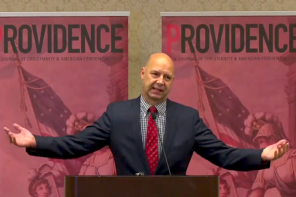What do you believe? You have 140 characters-give us your statement of faith in 140 characters. #TOF.
This was the challenge, issued by blogger Shawn Coons a few months ago. He asked: “instead of a statement of faith, how about a twitter of faith?”
Twitter is only two years old, but it is already the preeminent platform for what is called microblogging: a system for sending messages (quickly dubbed “tweets” by users) of no more than 140 characters to friends, family (and increasingly, customers or fans) who have signed up to receive them. [For an example take a look at RD’s own Twitter feed -The Eds.]
Enter the Twitter converts.
Some religious believers are avidly developing in-tweet content and symbols to spur sharing, replicating, and searching faith-related content online. In line with religiously shaping of previous forms of media innovations, faithful bloggers, or in this case, the “Twitness,” has emerged to shape the blogosphere, creating new faith connections.
Twitter asks the simple question: “What are you doing?” Some evangelical Christian groups are harnessing these coincident messaging flows to strengthen their religious communication via synchronized prayer. Consider the Calvin Institute of Worship’s setup of an automated Twitter feed to “pray the hours.” Inspired by the Holy Scripture’s injunctions to “pray without ceasing” (1 Thessalonians 5:17), users can sign up to receive hourly prayers sent in verses of brief twitter feeds or view a “Tweetgrid” with all prayer feeds to prompt continuous prayer or help those who are unsure of what words to pray.
In this way, contemporary believers may reinvent the century-old practice of praying set prayers from the Bible, hymns, and devotionals and matching prayer rhythms with fellow believers at designated times of the day. This also brings to mind the Pentecostal religious practice of prayer chains, where lay followers are charged to pray on particular topics, during particular hours, and for the same length of time.
Another organization, WeTheChurch.org has created a prayer/praise posting wall where online visitors can “throw out something” they need prayer for and expect other believers to pray for these needs. Need a prayer, write a quick prayer. Thankful for something? Submit a praise or Twanksgiving! Within 6 months of the site’s inception last year, the site received its 1000th request, attesting to the power and possibilities of religious mobile prayer on the go.
Retweets? Spreading the Faith
Given the burgeoning and increasingly diverse user base, another likely vision for Twitter is as a micro-sharing and mobilization platform for religious organizations. Its open and free message-spreading or “retweeting” meme mechanisms can help build replications and enlarge informational networks.
Recent developments in what MIT media theorist Henry Jenkins calls “media convergence” point to significant effects of “transmediation” where religious stories may unfold across multiple media platforms. With the proliferation of Web-based and mobile communication devices, the production and dissemination of viral e-mail, instant messaging—and now tweets—may accelerate the speed and intensity of message spread and traction.
To this point, one pastor has blogged about how he had prayed about a prayer request that he had received on Twitter, and in turn retweeted the message to everyone who followed him on Twitter. The use of Twitter is highly intertwined with the use of other social media. Microblogging and blogging might well evolve into large-scale support networks for mobilizing churches and building relationships. Emerging research points to this pattern of weaving online and offline religious “bonding social capital” among networked believers. Microblogging may have positive and negative implications for religious organizations as it can lead to the strengthening or weakening of existing relational links.
Ambient Intimacy
I recently interviewed a pastor who talked about the need to build religious communities in new ways. She said that “the blog thing is a good idea for the church” and that “Twitter can be used for community building” to replace weekly updates or announcements about community activities from the pulpit. Microblogging helps to build a “portable church” where fellow believers can connect to each other via the thread of frequent, running commentaries of their everyday lives “because the church was not meant to be stuck behind walls.”
In this way, key to building the portable church is what some social commentators are now calling “ambient intimacy,” an enveloping social awareness of one’s social network. For believers, regular updates or prayer and praise requests can reverberate and contribute to faith dialogues. Depending on the content of the messages, this can ultimately extend and enrich the religious public sphere. For evangelicals and radical believers, such social small talk is given greater significance in efforts to achieve missional conquest, expiation of sin, and salvation. On the other hand, microblogging can contribute to internet radicalization of a malevolent kind, where we see microblogging and blogging of extremist networked believers, leading to Web 2.0 “cyber-herding” and an echo chamber of effect among fundamentalist religious ideologies.
Recall the Twitter of faith challenge.
Write a statement of faith in 140 words and pass-it-forward (like the viral game “25 things” on Facebook where members of the social network post 25 facts about themselves and “tag” 25 other people to do the same thing). Like mutating chain letters, the circulation of faith tweets may be conceived of media viral codes, with the ability to influence a society’s agenda—with real effects.
As such, microblogging represents an important part of the faith media menu and a spacious portal for thinking about religion, media and culture.




